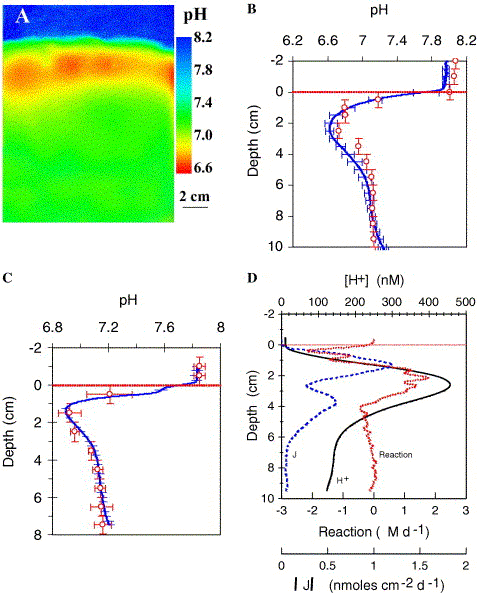
Fig. 2. pH distribution pattern in a largely vertically stratified sediment. (A) Two-dimensional pH distribution pattern (pseudocolored) in subtidal core and overlying water obtained from central Long Island Sound (35 m depth) (September 2003). No distinct burrows are present. (B) The average vertical pH profile of (A) calculated from each horizontal pixel layer (continuous line, ±SD) and that obtained from a minielectrode (open dots) at 1-cm interval measurements. (C) pH distributions in originally homogenized surface sediment obtained from central Long Island Sound (September 2004) measured with the planar fluorosensor (line) and a glass pH mini-electrode (dot) over 1 cm intervals (n = 6). The standard deviation of the fluorosensor measurements were calculated from each horizontal pixel layer (bar). (D) Total H+ concentration distributions, flux vector magnitudes, and net reaction rate averaged across the center 5.75 cm in (A). Model estimates using Eqs. (3a), (3b), (4) and (5) were made in the image plane only.

Fig. 3. pH distribution pattern in bioturbated marine sediment. (A) A visible image (green band) of intertidal sediment from Flax Pond (Long Island, USA) (October 2003) incubated for 8 days in the presence of N. succinea (white arrows). At least four burrows formed by the animals are evident at the time of imaging. The two burrows in the middle of the image are inhabited; the rightmost burrow structure was formed on day 1, and remained stable and intermittantly utilized thereafter; the leftmost burrow is younger and was formed on day 8. (B) Corresponding two-dimensional pH distribution of sediment (A). (C) The horizontal pH profile extracted along the black arrow in panel B. (D) The average vertical pH profile of panel B (horizontal average, ±SD) with minimum (square) and maximum pH (circle) in the calculated layer.
〔Zhu,Q., Aller,R.C. and Fan,Y.(2006): Two-dimensional pH distributions and dynamics in bioturbated marine sediments. Geochimica et Cosmochimica Acta, 70, 4933-4949.から〕